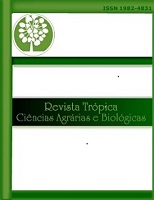FUNCTIONAL DIVERSITY OF TREE AND SHRUBY VEGETATION IN CERRADO AT DIFFERENT STAGES IN REGENERATION IN NORTHEAST BRAZIL
Keywords:
Functional traits, Ecological strategies, RegenerationAbstract
We seek to answer: Will functional metrics have a greater relationship with species richness in the conserved area? Will we find higher values of functional metrics in the conserved area? Will the average values of functional traits be higher for conserved areas and similar between areas undergoing regeneration? Will the areas present differences in functional composition, with turnover being more preponderant for functional beta diversity? We selected two areas with different regeneration times (18 and 35 years) and one preserved area and implemented a 50x50 m plot. We collected functional traits from 24 tree-shrub species from which the following were measured: leaf thickness, dry and fresh leaf mass, leaf area, specific leaf area and wood density. Only functional richness and species richness were related to species richness. We verified a difference in divergence and functional dispersion between the areas undergoing regeneration, the conserved areas presented the highest average values and the 35-year-old areas the lowest values. We evidenced a difference in the functional composition between the regenerating and conserved areas. The turnover value was 0.7101 and the nesting value was 0.150. The regeneration time and agricultural practice influence the functional composition, where we found that turnover is the most preponderant component for functional beta diversity.
Downloads
References
BASELGA A (2010) Partitioning the turnover and nestedness components of beta diversity. Global Ecology and Biogeography 19: 134-143.
CHUN J.H.; LEE, C.B. Temporal Changes in Species, Phylogenetic, and Functional Diversity of Temperate Tree Communities: Insights From Assembly Patterns. Frontiers in Plant Science. 2019.
CIANCIARUSO, M. V.; SILVA, I. A.; BATALHA, M. A. Diversidades filogenética e funcional: novas abordagens para a Ecologia de comunidades. Biota Neotrop. vol.9 no.3, 2009.
MARTIN, S. T & AMP; MALLIK, P. A. U. Alternate successional pathway yields alternate pattern of functional diversity. Journal of Vegetation Science, v. 30, n. 3, p. 461-470, maio 2019.
PÉREZ-HARGUINDEGUY, N.; DÍAZ, S.; GARNIER, E.; LAVOREL et al. 2013 New handbook for standardised measurement of plant functional traits worldwide. Australian Journal of Botany, 61 (3): 167-234.
TILMAN, D. Functional diversity. In S. A. Levin (Ed.), Encyclopedia of biodiversity (p. 109– 120). San Diego, CA: Academic Press. 2001.
TOLEDO-ACEVES, T.; LÓPEZ-BARRERA, F & VÁSQUEZ-REYES, V. Preliminary analysis of functional traits in cloud forest tree seedlings. Trees, 31(4), 1253–1262. 2017.
WHITFELD, TIMOTHY JS ET AL. Species richness, forest structure, and functional diversity during succession in the New Guinea lowlands. Biotropica, v. 46, n. 5, p. 538-548, 2014.
Downloads
Published
How to Cite
Issue
Section
License

This work is licensed under a Creative Commons Attribution-NonCommercial-NoDerivatives 4.0 International License.
Direitos autorais Revista Trópica: Ciências Agrárias e Biológicas
Este obra está licenciado com uma Licença Creative Commons Atribuição-NãoComercial-SemDerivações 4.0 Internacional.








